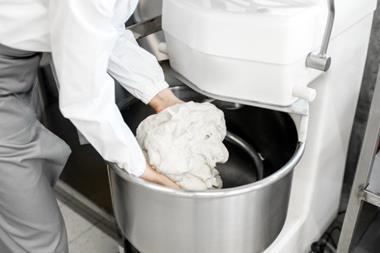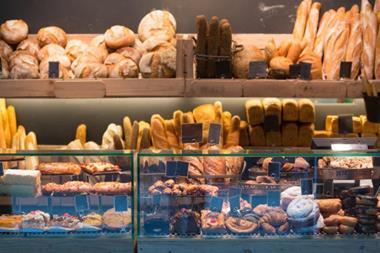In the third instalment of The Bakery Project we explore the importance of marketing, from getting the right look to stunning Instagram visuals
Image isn’t everything, but when it comes to building a bakery brand, it counts for a lot. After all, it’s important to stand out from the crowd.
As a baker, creativity outside the kitchen might not be your forte. You’ve got beautifully crafted wares to sell and a great location, but how do you draw customers in?
“It’s important to set out your stall, so to speak,” says Tricia Barker from Hertfordshire-based bakery and Baking Industry Awards winner Cinnamon Square. “You need to tell potential customers why they should come to you and notyour competitors, which you’ll achieve through marketing. Identifying and communicating your unique selling points (USPs) is essential.”
Marketing covers all manner of things – from the logo on the shop front, packaging and advertising, as well as social media activity. It’s how you promote the business to potential customers.
“To create a brand you can sustain and be proud of, you need to be honest from the outset about who and what you are,” explains Martyn Garrod, creative director at Soho-based agency Carter Wong Design. “Only by understanding the long-term vision and ambitions of a company can you craft a brand that will flex and grow with your business.”
While it’s tempting to start with the more fun visual elements of this, Garrod warns that design should not come first.
“Instead, your first decisions should be about your vision, mission and purpose – the essential building blocks of any successful brand,” he says. “Ask yourself what the ethos of the company is and let this guide what the brand looks and feels like.”
Tone of voice plays a key role here – serious or playful? Formal or informal? This depends on the business. Is it a playful doughnutterie underpinned by weird and wonderful creations or a patisserie creating intricate desserts? Or perhaps a craft bakery with a passion for real bread? Once answered, then the design work can get under way.
For some, it’s a simple process. “We developed our own brand and image,” says Julie Haylett, co-owner of Brighton’s Sugardough. The business was started by Haylett and her partner Kane McDowell in 2009 with a £100 oven from eBay and a rolling pin. Since then, they’ve opened another site in The Lanes in the seaside town, serving up handcrafted tarts, cakes and sourdough loaves.
“The red font of Sugardough and the blue/green stripes came about as a result of printing a large number of fonts and colours on a home computer and sticking them up all around our living room to see which one we liked. We wanted something that evoked a number of things: deliciousness, tradition, quality, fun.”
For those with a bigger budget, working with an external agency could be a good option, particularly if you don’t have an eye for design. Cinnamon Square, for example, took this route.
“We needed to communicate what our brand stood for and help our ideas come to fruition. This allowed our business to look instantly credible which reassures customers about their purchase,” Barker adds.
Online bakery business Kake and Cupkakery, which sells cupcakes and celebration cakes, also chose to work with a design agency for its recent rebrand.
“I understand how essential to a business the right branding can be, so I decided to go to an expert, invest and get a full brand identity created. I knew what I wanted to portray but didn’t know what my brand was going to look like” owner Yvonne Donald explains.
“Previously, I had a logo created in monochrome as I wasn’t sure what colours to use, but I was aware of colour psychology and how different colours can be perceived. With this in mind, I felt the time was right to invest in a new look and feel for my business and have a full brand identity created.”
The final look features a clean and modern design embracing the use of colours – turquoise, pink, yellow and purple – offering a range of on-brand options for packaging.
Good use of branding can bring credibility to a business, offering customers a complete experience from the moment they walk through the door, through to the last bite
of a baked treat. How far the branding extends depends on the business, its size, look and feel.
Cinnamon Square offers branded boxes for its signature product – the Cinnamon Square Bun. “This is a quality, premium product, so it was essential the packaging reflected this,” Barker explains. The logo also appears on cakes, breads and even some hot beverages, alongside staff uniforms.
Sugardough, meanwhile, opts for stickers on cake boxes and biscuit packaging for practical reasons.
“Generally packaging producers require branded orders to be in the thousands. As a small operator we couldn’t even store that number of bags and boxes, never mind use them in a timely manner. Moreover, the margins on bakery products are small, so a fancy bag may look nice, but not if it costs you the profit on what’s in the bag,” explains Haylett.
Like branding, marketing such as social media can be handled in-house or by an external agency. In the beginning, at least, many find they can’t justify the budget for external help. Despite the extra work, there are many benefits to doing it yourself, including the ability to react to real-time and local events, and tell potential customers what’s available that day. It also allows for a more personal experience.
“Love it or loathe it, social media is a cost-effective way to market your business and engage with your customers,” explains Stephanie Whitmore, food PR and marketing consultant. “Good social media is all about developing a good relationship with your followers, letting them get to know you, so they trust your brand rather than just pushing your services or products.”
Facebook is a good starting point for retail bakers, notes Whitmore, along with Twitter, providing you tailor the social media to your audience. Posting frequently is essential, as is replying to comments or posts your business is tagged in by customers. Sugardough suggests following food influencers in the local area.
Running competitions can also encourage engagement with your business, as can teaser campaigns in the run-up to the launch of new products or events.
“It’s easy to think you should be posting every day to make an impact, but research shows it makes little difference to the number of clicks and engagement. The quality of what you post is far more important,” adds Whitmore. “Typically, post around four or five times a week – more if you have an event or are launching a new product, for example.”
Scheduling tools such as Hootsuite or Buffer can allow users to line up content in advance, enabling bakery owners to get on with the day job as well.
“Food sells, so share your delicious bakes with photos, Instagram or Facebook live stories. Your customers will love to see behind the scenes and how things are made. Share your journey,” says Vhari Russell, founder of marketing agency The Food Marketing Expert. But don’t post the same content on Facebook, Instagram and Twitter, she notes.
Visuals are key for Instagram, of course.
“It’s all about eye candy,” says Tom Bandy, account manager at PR and advertising agency Shinebright. “Blurry shots are a definite no. Take time to check the background as well as the product in the shot. A sprinkle here, a prop there help to lift and vary the shot.
“Remember, you don’t just have to produce product shots; images of your employees at work, happy customers, even short videos are all great and help vary your feed. And don’t forget to hashtag your posts to help other people apart from your followers to find your content.”
In other words, just as you do with your bakes, embrace your creativity and stand out from the crowd.
Building a website
“Your company website isn’t a website, it’s the world’s eyes on your brand. It is the front line of your business.”
So declares Steven Foster, CEO of marketing agency The Magic Octopus, who urges business to invest in “stunning design and a user experience that is second to none”.
In contrast, Vhari Russell, founder of agency The Food Marketing Expert, recommends businesses keep the site simple, but invest in “mouth-watering photography”.
“We would suggest creating an information site that does not include a shop initially, so that you can promote what you do, where you do it and how you do it,” she adds.
“Share your news, keep your site updated, share blogs on tips and news and even make suggestions with recipes to use up leftover bread.”
As with social media, operating a website puts demands on you or your staff – not least of which is ensuring it is updated.
“There is nothing worse than out-of-date content on a website, it creates confusion in the audience,” says Foster.
There is also a risk that a website could become a drain on financial resources, as Cinnamon Square found when it realised it was investing too much in search engine optimisation and not getting a sufficient return.
“We deliberated far longer than necessary about cancelling as we were concerned that this would have a huge impact on bookings for courses,” explains Tricia Barker of bakery and café Cinnamon Square. “We should have gone with our gut instinct sooner.”
Five tips for building a website
The Federation of Small Businesses offers the following tips on building a website, and says it always pays to use a professional expert in web design.
Know your purpose: Consider your objectives. A website without direction can leave visitors uninformed of the true purpose of the business, and fail to generate the interest you need.
Make a good first impression: Your homepage is your shopfront. Clever calls-to-action and interesting relevant content, coupled with slick design, should draw visitors in and push them to explore further. Ask: what has brought the visitor to this point? What information do they need?
Prioritise preparation: Spend time planning the layout and wording for each page. Web developers use flowcharts as visual guides to outline the main structure – worthwhile in the planning phase. You’ll also need a web host: look for a service provider that offers reliable servers with a speedy performance and daily back-ups.
Design and usability: Template sites risk looking generic and offer little scope for change as your business grows, so an original design is probably best. Try to anticipate what your users might need. Ensure the website functions well from desktop to tablet to mobile.
Use a content management system: A content management system allows site owners to update the website as required. There are several open-source solutions – such as WordPress and Drupal – but bespoke systems are also available.
For more details visit fsb.org.uk
Q&A with YouTube’s Topless Baker
Say hello to YouTube sensation Matt Adlard, aka the Topless Baker. This shirtless hunk and self-taught baker has captured a generation of foodies through his how-to videos, stunning Instagram posts and aptitude for baking with his shirt off. British Baker caught up with him on the Brook Food stand at last month’s Foodex 2018 show – where he was demonstrating his skills – to find out how to make it big on social media.
You’ve got more than 200,000 subscribers on YouTube and another 200,000 on Instagram. Why do you think you’ve made it so big on social media?
It’s all about posting often, engaging with your audience and doing something different – in my case I’m topless. I was trying to be different and cutting edge. Find your niche. In baking there are so many people who can make good cakes and cupcakes, so it’s about how you can turn that on its head. Put some personality into it.
What platforms should smaller bakery business be looking at?
I’d say don’t create a YouTube channel because it’s so difficult – unless you get very famous, it’s hard to become successful on YouTube. Instagram is easier, it’s about putting up good-quality content regularly. If you do that you will be successful.
What about the other social media platforms?
Snapchat has a very young audience and you can be the best video-maker in the world on Snapchat, but it is still very difficult for people to find you, whereas Instagram has a discover function. On Instagram, people can repost your photos, so it’s a much more open platform for collaboration. Facebook is all about viral videos.
How can bakers know what trends to tap into on social?
The best trend is the one you create yourself. Other than that, it is the one the most people are recreating. Unicorns and rainbows are big right now, but you’ve got to make sure you jump on the trends early as you don’t want to be late to the game. Unfortunately that’s quite hard to work out as you never know what will pick up.
So what’s the next big thing?
If I knew that I’d already be doing it! It’ll likely be some variation on cake and unicorns. But mirror glaze is picking up interest.
Does it pay to advertise?
Financially, social media can be a relatively cheap way of marketing a business – although the cost in time should not be underestimated.
But what role does paid-for marketing, such as traditional advertising, have today?
“Paid-for advertising still has a big part to play in the marketing mix – particularly if you wish to target a business audience,” suggests food PR and marketing consultant Stephanie Whitmore.
“You may be a bakery ingredients supplier wishing to build awareness among bakery customers, for example, so paid-for advertising in a trade title such as British Baker – either in print or online could be part of your marketing strategy.”
She adds that, as with any business, it is important to set aside a budget, as well as time, for marketing, and advises seeking professional advice to ensure your budget is spent wisely.
“That ‘last minute’ radio campaign or advertorial might seem like a good deal, but is it going to reach the right people for your business?” she asks. “If not, don’t feel pressurised into saying yes.”
Getting to know local media organisations can pay dividends for a business.
“Look at affordable platforms such as a local titles, and offer to share recipes or supply product for review,” suggests Vhari Russell of The Food Marketing Expert.
Even a business that focuses on social media for promotion can benefit from paying to have its posts promoted.
“We do a small amount of advertising in one or two local publications, but primarily use social media for our online marketing” says Julie Haylett of Sugardough in Brighton.
“We advertise on Facebook by boosting posts and, generally, Facebook advertising works for us well. A good photo can get a lot of shares, likes and comments.”
Tips for social media success
Sue Souter, whose business Souter PR works with firms including Roberts Bakery, offers advice on making the most of social media:
Plan ahead What’s happening in your world, your customers’ world, the wider world? Develop a 12-month overview and more detailed monthly programme of posts. This will help ensure consistency and that no key opportunities are missed.
Imagery and video It shouldn’t all be words. And it doesn’t have to cost a lot. Think simple shots of fresh bakes or ‘how to’ masterclasses. Anything is possible.
No ‘hard sell’ Tempting as it may be, it is more valuable to educate – your passion, people and unique story. Authenticity should be a key attribute for every plan.
Make your mark Take time to consider and create stand-out content that people will recognise and respond to. Get creative friends, family and colleagues to add their ideas.
Your audience Be clear whom you want to attract to your community. They must want to follow you. What can you do and say to encourage them? And how do you keep them?
Experiment These are fast-moving channels. When something works, do more of it. If it doesn’t it will be quickly forgotten.
Evaluate success Use the free analytics available and set some targets. Use what has worked well for you to inform content planning.
Build your following Follow your customers, key media and key influencers. Share their posts, be sociable and your network will grow organically. And keep an eye on what your competitors and brand leaders are doing.


























No comments yet